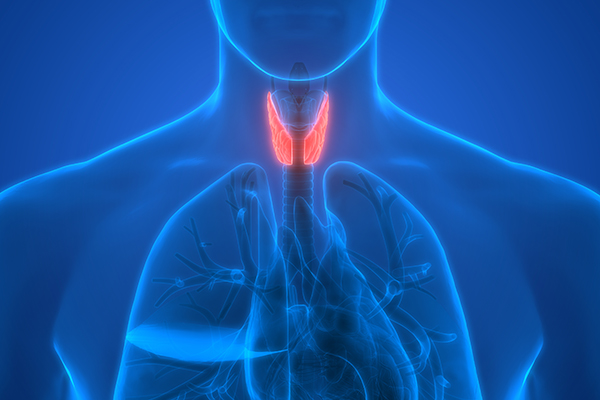The Role of Pathology in Understanding Thyroid Cancer
By Jane Meggitt
Thyroid cancer accounts for about 1 percent of all cancers diagnosed annually in the United States, or 64,000 cases. The good news is that thyroid cancer patients have excellent survival rates when the disease is caught early. As it does with all cancers, pathology plays a critical role in the diagnosis of thyroid cancer and the treatment decision-making process.
Thyroid Cancer
Located at the base of the neck and around and against the trachea, the butterfly-shaped thyroid gland regulates many bodily functions. There are two primary types of cells in the thyroid gland: follicular and C-cells. The former create thyroid hormone from iodine in the blood. The latter make calcitonin. This hormone assists in controlling how calcium is used in the body.
Thyroid cancer may develop in thyroid nodules, small solid or fluid-filled lumps forming within the gland. These lumps are often detected by doctors during routine exams, although they may grow large enough for the patient to feel it themselves. In some cases, the nodules may make breathing or swallowing difficult.
Most nodules are not malignant. When the pathologist does diagnose a nodule as cancerous, subsequent treatment is based on their report. This report includes the type and stage of thyroid cancer. Pathologists, in conjunction with other doctors, recommend a treatment strategy depending on the individual test results.
Fortunately, surgery to remove the thyroid gland or radioactive iodine therapy is often curative.
Types of Thyroid Cancer
There are five types of thyroid cancer:
- Papillary thyroid cancer –This most common type of thyroid cancer involves usually slow-growing tumors that may spread into the lymph nodes.
- Follicular thyroid cancer –Also slow-growing, but less likely to spread to the lymph nodes.
- Medullary thyroid cancer –C cells can develop into this rare cancer. It often runs in families.
- Anaplastic thyroid cancer –This rare cancer grows quickly. Successful outcomes depend on early detection.
- Hürthle cell neoplasm –While uncommon, Hürthle cell neoplasm proves more aggressive than follicular cancers.
Fine-Needle Aspiration Biopsy
The doctor performs a fine-needle aspiration biopsy to collect a small sample of thyroid tissue to forward to the pathology lab. Guided by ultrasound, the physician inserts a long, thin needle into the skin and then into the thyroid nodule. Via the needle, suspicious tissue samples are removed. The pathologist will look for cancer cells. They then write a report on the testing results.
Sometimes, it is not possible for the pathologist to determine definitively whether the thyroid nodule is cancerous. In such instances, another biopsy is performed for further testing. If results are still inconclusive, the patient may undergo a hemithyroidectomy, or removal of one-half of the gland. The pathologist is then able to make a definite diagnosis.
The Bethesda System
Introduced in 2007, the Bethesda System for Reporting Thyroid Cytopathology standardized thyroid cytopathology reporting. Under the Bethesda system, there are six tiers. Each category includes its own criteria.
- Nondiagnostic
- Benign
- Follicular lesion atypia of undetermined significance
- Follicular neoplasm or suspicious for follicular neoplasm
- Suspicion for malignancy
- Malignant
Neoplasm, or suspicious for neoplasm, is divided into follicular neoplasm and Hürthle cell neoplasm.
Thyroid Cancer and Lymph Nodes
Thyroid cancer may spread through the central compartment lymph nodes. These are the lymph nodes around and below the thyroid gland, trachea, and esophagus. These lymph nodes are found between the carotid arteries, extending beneath the breast bone. Thyroid cancer may also metastasize through the lymph nodes located on the side of the neck.
The pathologist documents whether cancer cells are present in the lymph nodes. If the lymph nodes are positive for thyroid cancer, the doctor may opt for extensive removal of lymph nodes from the neck area. This surgery is followed by radioactive iodine therapy, chemotherapy or targeted drug therapy.
Contact Us
At Yosemite Pathology and Precision Pathology, we partner with THYROC ™, the premier provider of thyroid pathology services. All work is performed by extremely experienced, board-certified cytopathologists with a special interest in thyroid pathology. Because these pathologists are so well-versed in their field, they have the ability to identify rare thyroid-related cancers that those with less specialization may miss.
We adhere to Bethesda criteria for clear and definitive cytopathology with a low rate of indeterminate results. To learn how your hospital and practice can benefit from our testing services and specialties, including THYROC™ Thyroid Pathology, contact us today.
Jane Meggitt’s work has appeared in dozens of publications, including USA Today, Zack’s, Financial Advisor, nj.com, The Houston Chronicle and The Nest. She is a graduate of New York University.
Thyroid Fine Needle Aspiration Biopsy | Johns Hopkins Medicine
Papillary thyroid carcinoma: an update | Modern Pathology (nature.com)
Thyroid cancer – medullary carcinoma: MedlinePlus Medical Encyclopedia

